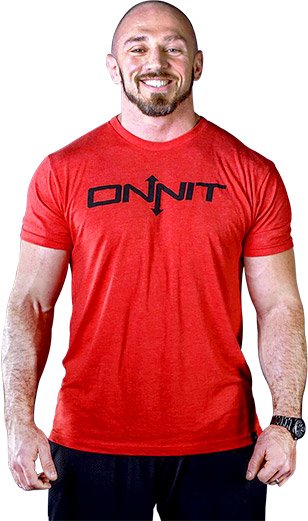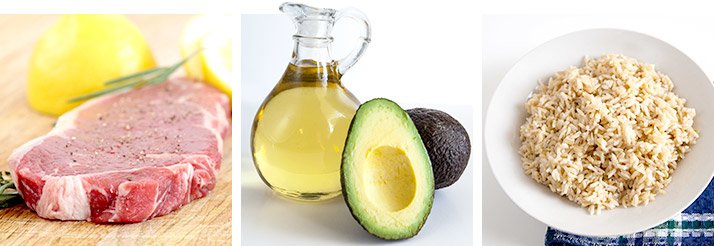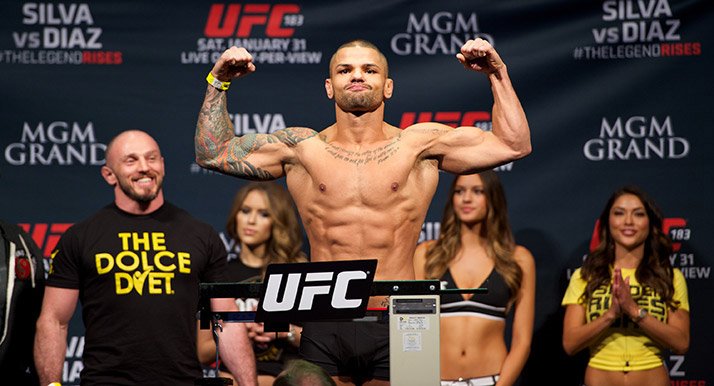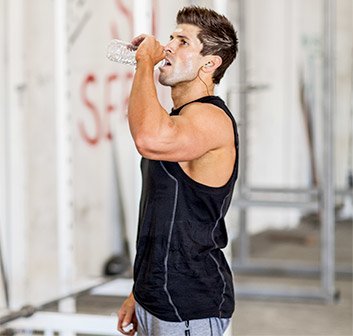
Micronutrients Matter: 5 Keys To A Great Diet
Learn the secret that has been helping the world's top fighters add years—and belts—to their careers. Make one simple change to your nutritional priorities, and watch your health and performance skyrocket together!
Not very long ago, I was a 282-pound powerlifter with a single goal: Get big or die trying. Yep, I even wore the T-shirt. As fate would have it, it seemed I was on track to achieve both goals.
One day in my mid-20s, I stumbled into my doctor's office and found out my cholesterol, blood pressure, and other risk factors for lifestyle-related illnesses had escalated as fast as my squat, bench, and dead. My mind was blown. How could this be? I trained religiously, never missing a workout since I was 13 years old. I took every "sports supplement" known to man and I ate like a horse—not exactly clean, but not nearly as bad as most other people I knew.
And yet, I wasn't healthy. Before you lob some insult about chubby powerlifters, let's be clear: There are plenty of bodybuilders, CrossFit fiends, and other awesome athletes right in the same boat.
It turned out I was living a lie. I was letting the scale and the weight on the bar delude me into thinking all my goals were aligned. In fact, they were not. I was taking great risks with my health, to satisfy nothing more than my own ego.
It hurt—but the most important truths always do. There had to be a better way! And it turned out there was, but it required me to take my most cherished nutritional "truth" and knock it down a peg. Here's how.
Your performance or your life?

After half a dozen or so follow-up tests with my doctor (EKG, MRI, Holter monitor, and much more), the basic conclusions hadn't changed. I was giving up years on the end of my life to make the most of the ones in my athletic prime. Many of you are undoubtedly doing the same thing, whether you know it or not.
But now I knew—and I decided enough was enough. I wasn't going to give up training—definitely not—and I wasn't going to stop eating to support my performance gains. But I also wanted to feel energized and live a long, productive life.
This is when I started taking my experience with performance science and combining it with something I didn't know as much about: the science of longevity. Having studied nutrition in school and worked as a general manager in one of the most popular supplement chains to pay for that school, I felt like I was a qualified expert on diet. I was running a successful training business and coached athletes who won titles in a wide range of disciplines.
Again, my ego deluded me. I had a lot to learn.
But over the months and years after that startling wake-up at my doctor's office, I came to see how nutrition and lifestyle were the keys to my salvation. I devoured as much information as I could on how the body works as a living organism, studied cultures around the world, analyzed ultra-endurance athletes, and—most difficult of all—reexamined the past decade or so in my own development.
I started to experiment on myself, and once I found something to be effective, I shared that with my stable of athletes. It was a big risk, but the results were astounding! Not only did we get leaner and stronger, we were able to think more clearly, too. Our skin and hair looked younger and healthier. Even our fingernails would need to be cut much more often. It was like living in a sci-fi film.
What was the difference? In a word, micronutrients.
Getting Under the Microscope
As brothers and sisters of iron, we're all aware of the necessity of a complete macronutrient profile to foster muscle gains, support performance, and decrease body fat. For those of you who aren't in the know, the three macronutrients are protein, fat, and carbohydrates. These are the primary nutrients that equal our total caloric consumption, with protein and carbs equaling four calories per gram, and fat equaling nine calories per gram.
Since the first time I opened a FLEX magazine as a kid, I had always focused on my macros. I did what was necessary to ensure I consumed at least 1.5 grams of protein per pound of lean body mass, twice that in carbohydrates, and usually let my fats fall where they may. I had never really paid attention to food quality outside of those macros, though. If I hit my targets, and my calories more or less lined up with whatever equation I favored at the time, everything else was cool.

This was my religion. Did I see progress in the gym as a result? Definitely. But to be honest, I never felt quite as amazing in "real life" as I should have.
During those six months of reflection and research, I realized that the human body is much more than macros. There is a whole other tier, much more important than macros lying just beneath the surface. This realm is where your gains are truly made.
I'm talking about micronutrients. These are the essential components that help all the systems of your body run at full capacity.
You may already know that micronutrients are important in theory. But here's what you might not know: Without fully satisfying your micronutrient needs, your precious macronutrients will not be utilized effectively. You'll end up wasting your time, energy, and training, and leave both gains and health goals unrealized.
So how do you get them? You have to change your nutritional priorities.
Make Micros Matter
By day, I train high-level UFC athletes like Vitor Belfort, Ronda Rousey and Thiago Alves. Each experienced a career-defining resurgences when they adopted a whole-food-based lifestyle focused first and foremost on complete micronutrient fulfillment.
Think of micronutrients as the worker bees who work to manufacture honey out of the raw materials of carbs, fat, and protein. They make it useful. And fortunately for you, they're easy to find in the store.

Do we still balance macronutrients? Of course! But our priorities are ordered more like this:
- Micronutrient intake
- Macronutrient intake
- Meal timing
- Nutrient pairing
The results speak for themselves. Each of these athletes' bodies looks good enough to step on a physique stage, while having the stored energy to compete for 25 minutes at their full potential—although Ronda usually needs a fraction of that amount of time. This is because of our dogmatic focus on the health of the human organism.
When your micros are in balance, it's easy to fit your macros into the most effective ratio for your body. But if you only focus on your macros, your micros may fall short, potentially reducing your gains and shaving years off your career and your life.
Five Principles to Eat, Live, and Thrive By
Why don't micronutrients get top billing? Simple: because nobody knows all of what micros do, or how they do it. It's entirely possible that we never will. But honestly, that's not a problem. Prioritize them in general, and you'll get what you need.
If you follow these tried-and-true principles of The Dolce Diet and Onnit Foods, you'll be well on your way to meeting all your health, fitness, and performance goals. You may be shocked at how simple it can be.
1Eat earth-grown nutrients
That's right, real food. If you focus on eating real food, and eating it as closely as possible to its natural habitat, you will be consuming the most nutrient-dense materials you can. Nutrient density—that's the key here.
Other rules to maximize nutrient density: Fresh is always best. Raw is usually best. Pesticides, chemicals, preservatives, and growth agents—they all detract from the overall nutrient content of food.
Whenever possible, choose meat from animals that have eaten what they've eaten for centuries—or even better, animals that lived in the wild. Eat potatoes that come out of the same ground you tread on, or apples picked ripe from a tree near you.
What's the alternative? You know it well. An apple gets picked two weeks before it's ripe, shipped thousands of miles to a grocery store, and then sprayed with wax to get that nice phony glow. This exacts a toll both in terms of taste and nutrition. As for me, I want my food to go bad a day or two after it is harvested, because that means it is real food—not just somebody's approximation of it.
ONNIT Ultimate Grocery Guide
2
Eat every 2-4 hours, based on what you just did or are about to do
This concept should be familiar to most of us who have a few years in the strength game. How it plays out can look different for different athletes. A fighter looking to make weight will eat different quantities at different times than, say, a bodybuilder looking to add mass. Different training, different goals, different foods, different amounts.
But the rule itself holds. My athletes are always thinking about preparing their body for work to come, or helping it recover from work performed. You should, too.
3Eat until satisfied, not until full
This concept may be hard for many to swallow (see what I did there?), simply because extreme excess has become the norm. But one of the many upsides of nutrient-dense eating is that you no longer need to stuff yourself with immense amounts of poor-quality food to get everything you need. Eat better, and you'll use more and waste less.
On the other hand, when we eat too much, our digestive systems pay the cost—tell me if you've been there before. We also end up missing out on some of the vital nutrients we think we're delivering to our hungry muscles. Don't let gluttony get in the way of your gains! Cultivate the skill of listening to your body, and it'll let you know when it's had enough.

Drink lots of water
Over 70 percent of our body is made from water—not soda. Water is present in every cellular interaction of the human body, and that definitely includes muscular contraction. Even the mildest of dehydrated states can impact strength and performance, although you may not know it's happening at the time.
My rule is: After my first urine of the day, all others should be clear. This is the only way, without expensive testing, I can accurately gauge my hydration levels. As a 220-pound man, I drink two gallons of purified water every day. My wife is 125 lbs., and she drinks one gallon of water every day. This is in addition to—not instead of—any coffee, fresh-brewed teas, cold-pressed juices, or smoothies we may consume.

As to other beverages, we don't consume them. Why should we? If making gains is the goal, keep it simple, keep it real, and keep it pure.
5Stay accountable
I can't tell you how many times I've heard this: "Coach, I just can't gain/lose weight, and I eat perfectly all the time!"
My response is always the same: "What did you eat this morning?"
"Well, this morning was different. My kid was sick, and I couldn't make my normal breakfast and blah, blah, blah..."
So the story goes. When I say "be accountable," I'm talking about every meal, every day, every week, every month, every year. There is no cheating in my system. There are only gains or no gains.
Now, don't get your panties in a bunch and start dropping that "refeed" body-babble on me. Sure, we have refeeds—fighters need them, particularly after weigh-ins—but they're still with nutrient-dense foods.
In the Kitchen with The Dolce Diet Post-Weigh-In Pasta
Here are some solid refeed options:
- "Power Pasta" made with high-quality meat, fresh vegetables, and pasta made of brown rice or quinoa
- Elk burgers with homemade sweet-potato fries
- A grass-fed steak or wild-caught fish paired with a baked potato, some rice, and a ton of green veggies
The point: You don't have to poison yourself in order to refeed or be social. In no way is my life restricted. Better yet, it's enhanced! The Pop-Tart and ice cream eaters can scoff all they want, but why pop a tart when you can enjoy the same macro profile while also maximizing your micro profile? It's wasting a meal if you simply dump that sludge into your body when there are much better options out there.
Give your body what it really needs
Don't let the obesity stats fool you. This movement is growing fast! We as a population are becoming more educated consumers, and more of us than ever are realizing the long-term impact of our nutritional choices.
Food companies large and small have seen this trend and are accommodating with a growing supply of organic, fresh food options. The supplement industry has taken notice as well. There are more options now than ever for products that contain the highest quality of all-natural ingredients, without the downside of artificial sweeteners, preservatives, and color additives.
Don't just survive—optimize your health! You can look good on stage or standing in front of a mirror, while also leading a longer, more fulfilling life. Eat better, and you'll be better.
References
- Shenkin, A. (2006). Micronutrients in health and disease. Postgraduate Medical Journal, 82(971), 559-567.


